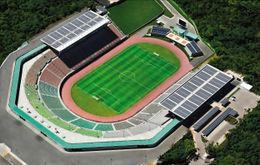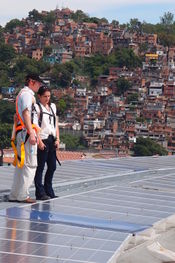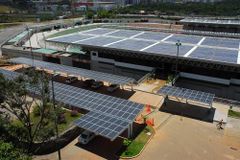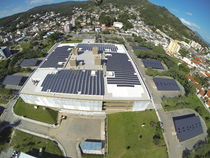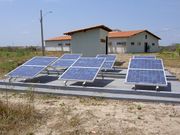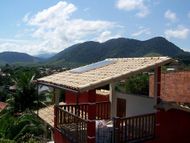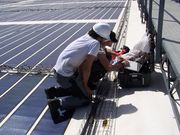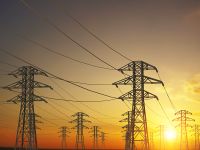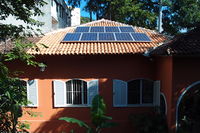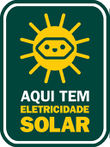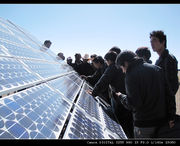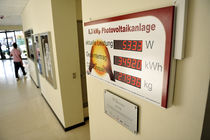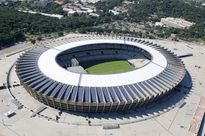Difference between revisions of "Chisomo (Cookstove DB)"
***** (***** | *****) (CSV import) |
***** (***** | *****) (CSV import) |
||
| Line 1: | Line 1: | ||
| + | = Overview<br/> = | ||
| + | '''<span>Organizer:</span>'''<br/> | ||
| + | <span>[http://www.geographie.uni-bonn.de/research/scientific-domains/economic-and-social-geography Workspace Economic and Social Geography/Department of Geography of the University of Bonn (GIUB)] and Working Group of Geographical Energy Research of the </span>[http://dgfg.geography-in-germany.de/ German Society for Geography (DGFG)]<br/> | ||
| + | '''<span>Date:</span>'''<br/> | ||
| + | <span>Friday 21 and November 22, 2014 at the </span>[http://www.geographie.uni-bonn.de/ Institute of Geography, University of Bonn]<br/> | ||
| + | <span>The transition to renewable energy and carbon-neutral energy supply has become an important policy objective worldwide. In this context, country-specific differences in development paths can be observed. In particular for "energy-hungry" emerging markets, but also for other countries and regions in the global South, the transformation of energy systems opens up the opportunity to learn from leading countries. The geography with its focus on integrating perspectives can make a valuable contribution to this topic. Against this background, the annual meeting in 2014 deals with international perspectives of energy geographies.</span> | ||
| + | = Global Perspectives of Renewable Energies<br/> = | ||
| + | Speaker: <span>Ruud Kempener (analyst for technology project plans for [http://www.irena.org/home/index.aspx?PriMenuID=12&mnu=Pri IRENA]), per pro. for Roland Roesch (Senior Programme Officer, Renewable Energy Markets and Technology Dialogue with IRENA)</span><br/> | ||
| + | In this lecture, key issues and questions of the nexus energy, geography and development have been identified: What are key sectors of the energy sector ? To what extend are renewable energies (RE) and energy efficiency relevant for future growth? How can you open up the use of renewable energy even further? How to finance the use of RE? Who plays central roles in the field of RE? ( Private actors such as companies, institutions and households, state actors such as government bodies of the Government of India/cp. Point 3, Universities etc. | ||
| + | <br/> | ||
| + | = Bioenergy and Development in Tansania<br/> = | ||
| + | <span>Speaker: </span><span>Harry Hoffmann (PhD student at the [http://www.zalf.de/en/forschung/institute/soz/Pages/default.aspx Institute of Socio-Economics] of the </span>[http://www.zalf.de/de/Seiten/zalfaktuell.aspx Leibniz - Centre for Agricultural Landscape Research (ZALF) e. V.)]<br/> | ||
| + | <span>The central question of the speakers in this session has been: how can the production of charcoal, an important energy source in developing and emerging countries, be shaped more sustainably? Mr. Hoffmann focused on Tanzania. There, charcoal is an important source of energy that is often processed illegally and very inefficiently. In the past, actors in charcoal production have often been driven into illegality by the state. The degree of efficiency of charcoal produced is often only 10-15 %. Therefore, a high consumption of wood per unit heat value is the result. The tanzanian charcoal is often made with improvised and very primitively built charcoal kilns. This fact contributes to the low quality of the products. As a positive example, Mr. Hoffmann presented a project, which was carried out in a tanzanian village in 2010. Significantly improved kilns for charcoal production and Improved Stoves were used for combustion, which could significantly reduce both indoor air pollution and charcoal consumption. Therefore, the project began to bear fruit in the sustainable production of charcoal. </span><br/> | ||
| + | <span>Conclusion: i</span><span>n general, charcoal production in developing and emerging countries is often unsustainable and inefficient. In the example, the combination of more efficient charcoal production and lower consumption, has however proven to be an important and successful milestone towards the goal of greater sustainability.</span><br/> | ||
| + | <br/> | ||
| + | = Barriers for the Successful Use of Existing Biomass Potentials in East Africa<br/> = | ||
| + | <span>Speaker: Fabian Schwarz (Researcher at the [http://www.lsge.uni-bayreuth.de/en/index.html Department of Development Geography] (Prof. Dr. B. Lohnert ), [http://www.uni-bayreuth.de/index.php University of Bayreuth])</span><br/> | ||
| + | <span>Mr. Schwarz presented two case studies from Uganda and Tanzania to present barriers to the use of biomass. In both countries, the supply of electricity is on a low level and both countries have missed their current 10-year plans with respect to increasing the efficiency of energy use. </span><br/> | ||
| + | <span>Black identified the following barriers: </span><br/> | ||
| + | *<span>funding </span><br/> | ||
| + | *<span>market failure </span><br/> | ||
| + | *<span>legal framework </span><br/> | ||
| + | *<span>missing human skills in dealing with RE </span><br/> | ||
| + | <br/> | ||
| + | <span></span><span>A plant that produces sugar from sugar cane served as an example. The molasses, a waste product, was usually disposed of unused. The molasses can, however, be used as fuel for biogas plants. By using the molasses for power generation, huge potentials could be opened up in Uganda. Necessary to this, is however investment in education and training programs. </span><br/> | ||
| + | <span>Conclusion: in Uganda and Tanzania, many such political and institutional barriers exist, that impede the success of similar enterprises. They can be overcome through improved training and further education.</span><br/> | ||
| + | <br/> | ||
| + | = Renewable Energies in Sub-Sahara Africa: A Case Study of Gambia<br/> = | ||
| + | Speaker: Pascal Ripplinger (Graduate Student at the Institute of Geography, University of Bonn)<br/> | ||
| + | Gambia is the smallest african country. The national electricity supply is mainly provided by diesel generators. The country is highly vulnerable to supply shortages in oil and fuel supply. Electricity prices are high. Renewable energy are an alternative to this inefficient and outdated system: one can create decentralized renewable energy solutions for the power supply. A nationwide expansion of the national grid based on existing technology would be expensive and would come with a high amount of emissions.<br/><br/>Incentives for the use of RE can be:<br/> | ||
| + | *tax benefits<br/> | ||
| + | *land grants<br/> | ||
| + | *general legislative and legal support of RE<br/> | ||
| + | <br/>Obstacles to the use of RE are currently :<br/> | ||
| + | *systems with RE require high investment costs<br/> | ||
| + | *capital is rarely available<br/> | ||
| + | *interest rates are normally high and the payback periods are short<br/> | ||
| + | <br/> | ||
| + | Improvements in this situation may be:<br/> | ||
| + | *an expansion of the national grid is hardly possible without increased emission of pollutants; because in Gambia power is currently produced primarily by diesel generators, an extension of the network would inevitably mean an increase in generator capacity; decentralized renewable energy plants are an alternative: small wind turbines and solar systems for local power supply have already been tried out<br/> | ||
| + | *in addition, a technical degree program at national universities is planned to train actors in the handling and maintenance of renewable energy plants<br/> | ||
| + | <br/> | ||
| + | = <span>Initiators of Change in Multi-Level Systems: Renewable Energy in Indonesia and the Philippines</span><br/> = | ||
| + | <span>Speaker: Jens Marquardt (PhD student at the [http://www.polsoz.fu-berlin.de/en/polwiss/forschung/systeme/ffu/ Environmental Policy Research Centre, Free University of Berlin])</span><br/> | ||
| + | <span>Energy and Southeast Asia: the economically powerful nations in Southeast Asia (Indonesia and the Philippines ) have a high energy consumption. It is important to mention that these regions are sustainably directed at multiple levels, both national and international. This multi-level control has been favored by the downfall of authoritarian regimes in Indonesia and the Philippines. Currently, a radical process of decentralization begins. Now, also sub-national actors play a central role in the field of renewable energy and should be regarded as new Drivers for Change. Unfortunately, key actors still often turn out to be obstacles (banks and other finance intermediaries).</span><br/> | ||
| + | <br/> | ||
| + | = Comparison of Off-Grid Electrification vs. Grid Extension: Influencing Parameters and the Role of Renewable Energies from a Geographic Point of View<br/> = | ||
| + | <span>Speaker: Catherina Cader (PhD student at the [http://www.uni-marburg.de/ Philipps-University of Marburg] and assistant at [http://www.reiner-lemoine-institut.de/ Reiner-Lemoine Institut Berlin])</span><br/> | ||
| + | <span>The Reiner Lemoine Institute in Berlin has a variety of software solutions that allow the determination of optimal locations and parameters for renewable energy. Ms. Cader presented Cameroon as an example. The country was evaluated by means of the multiple parameters of the software (wind speed, solar radiation, vegetation, connection to the national grid). By using the results, a map with recommendations for mini-grid locations was created, with which users can estimate at which locations the creation of a mini-grid is more suitable compared to an extension of the national electricity grid.</span><br/> | ||
| + | <br/> | ||
| + | = <span>The Great Appetite for Energy: A Comparison of China and India</span><br/> = | ||
| + | <span>Speaker: Dr. Thomas Henning (Research Assistant at the Philipps - University of Marburg)</span><br/> | ||
| + | <span>India and China as emerging economies are experiencing high economic growth, which is associated with an increasing energy demand. With regard to the electricity market, both countries have the world's third largest growth rates. Usually, carbon-intensive electricity generation is the result. Both India and China expand their energy portfolio involving RE. A large share of RE in turn accounts for hydropower, one can speak of a current renaissance of this energy in India and China. The common border region in the far east of India is a key region in the two countries. However, both countries are faced with severe difficulties when it comes to energy transport over long distances. China has many dams in the southwest of the country, which are used for the production of hydro power. On the border with India, several major projects are under construction. Especially in the catchment area of the Irrawaddy several such projects are planned. However, the danger arises that downstream areas can dry out across national borders. This plays is especially important in the politically volatile border region of India to China where such dryings have the potential to intensify political conflicts.</span><br/> | ||
| + | <br/> | ||
| + | = <span>Keynote Lecture: The Energy Transition, the Logic of Decentralization and the Economics of Re-Municipalization</span><br/> = | ||
| + | Speaker: Prof. Andrew Cumbers ([http://www.gla.ac.uk/schools/business/ Adam Smith Business School, University of Glasgow])<br/> | ||
| + | <span>The change from conventional to renewable energy resources in the context of generation of energy opens up new political opportunities, economic difficulties and new geographic focal points. The focus shifts from national electricity systems towards decentralized networks. This results in the rise of tensions between established privatized parties in energy supply and new demands to make the supply of power more democratic and collective. New approaches on municipal and local levels arise against neoliberal tendencies, privatization and competitive trends.</span><br/> | ||
| + | <br/> | ||
| + | <br/> | ||
| + | = Introduction<br/> = | ||
| + | Currently, solar energy plays just a marginal role in Brazil’s energy supply. The almost endless solar resources have no market for small scale solar systems. However, the new Net Metering regulation 482/2012, introduced by the Brazilian electricity sector regulatory body (Agência Nacional de Energia Elétrica, ANEEL), has finally opened the doors to tap a vast potential for decentralized small scale electricity generation up to 1 MW. It is a big step for Brazil´s renewable energy sector and great opportunities for German technologies in the Brazilian market. The cooperation of the Deutsche Gesellschaft für Internationale Zusammenarbeit (GIZ) GmbH, acting on behalf of the German Federal Ministry for Economic Cooperation and Development (ger. <span class="st">''Bundesministerium für wirtschaftliche Zusammenarbeit und Entwicklung'', </span>BMZ), and Brazil is helping the Brazilian partners to develop new ways of tapping the enormous potential for using renewable energies and to promote energy efficiency, particularly in industry and buildings. GIZ provides advice on strategy development, support for developing management and cooperation structures, and technical expertise within the framework of the German Cooperation for Sustainable Development.<br/><br/><br/> | ||
| + | |||
| + | === Articles<br/> === | ||
| + | [[:File:From the first solar-powered stadium in Latin America to PV Business for everybody.pdf|From the first solar-powered stadium in Latin America to PV Business for everybody (2013)]] <br/> | ||
| + | [[File:Pituacu Solar Stadium.jpg|border|right|260px|Solar Stadium Pituaçu - Salvador da Bahia (Brazil)|alt=Pituacu Solar Stadium.jpg]]<br/>[[:File:Vom ersten Solarstadion zum brasilianischen Net Metering.pdf|Vom ersten Solarstadion Lateinamerikas zum brasilianischen Net Metering (2013)]] <br/> | ||
| + | In 2012, the first Brazilian photovoltaics pilot project, the solar-powered stadium Pituaçu in Bahia state was inaugurated. This successful venture, implemented by the local energy provider COELBA and supported by GIZ, established further progress to increase the share of photovoltaic-generated electricity in the Brazilian energy system. Consequently, ANEEL introduced a Net Metering system within a new regulation for decentralized small scale electricity generators up to 1 MW.<br/><br/>[[File:Rooftop of Solar Stadium Maracanã - Rio de Janeiro.jpg|border|left|175px|Rooftop Solar Stadium Maracanã - Rio de Janeiro (Brazil)|alt=Rooftop of Solar Stadium Maracanã - Rio de Janeiro.jpg]][[:File:PV businesses up to 1 MW under Brazils new Net Metering rules.pdf|PV businesses up to 1 MW under Brazils new Net Metering rules (2013)]]<br/>[[:File:Net Metering in Brasilien - Wirtschaflichkeit PV für Haushalte und Gewerbe.pdf|Net Metering in Brasilien - Wirtschaflichkeit PV für Haushalte und Gewerbe (2013)]]<br/> | ||
| + | <br/>This paper assesses the profitability of decentralised electricity generation within the Brazilian housing and commercial sectors using the example of photovoltaics in the context of the introduction of the Net Metering system. The analysis is limited to the low-voltage level, since it has by far the highest retail tariffs.<br/> | ||
| + | <br/>[[:File:Net Metering in Brasilien - Bilanz nach einem Jahr.pdf|Net Metering in Brasilien - Bilanz nach einem Jahr (2014)]]<br/> | ||
| + | <br/>The article gives a review of the progress of the Brazilian Net Metering system after approximately one year since its introduction (12/2012). Trends and challenges to new grid connections as well as funding and incentivizing measures are important issues referring to this.<br/><br/><br/> | ||
| + | |||
| + | |||
| + | === Fact- & Infosheets === | ||
| + | [[File:PV Rooftops Parking Lot Solar Stadium Pituaçu.jpg|border|right|240px|Parking Lots Solar Stadium Pituaçu - Salvador da Bahia (Brazil)|alt=Parking Lots Solar Stadium Pituaçu]] [[:File:Infoblatt Pituaçu.pdf|Pituaçu Solar - Das erste Solarstadion Brasiliens (2012)]]<br/>Within the technical visit of a Brazilian delegation in Germany 2009, the idea to utilise public´s attention on world cup 2014 in Brazil to introduce catchpenny photovoltaic projects through football was born. Shortly after, the Brazilian energy supplier COELBA introduced a pilot project to build the first Brazilian solar stadium Pituaçu, with a capacity of 400 kWp. Financed by ANEEL’s Energy Efficiency Program PEE (port. ''Programa de Eficiência Energética''), the German-Brazilian EPC ''Gehrlicher Ecoluz Solar'' realized the installation of the system. The German Cooperation for Sustainable Development supported the project with technical advice on planning and choosing the execution company as well as obtaining the permission to introduce the produced electricity via net metering into the grid. This successful venture released to investments of 2 Mil. Euro from the Brazilian private sector, applying 60.000 Euro of German public tax resources for the project.<br/><br/>[[:File:Infoblatt Unbürokratisches Net Metering.pdf|Unbürokratisches Net Metering für dezentrale Stromerzeugung in Brasilien (2013)]]<br/>Reduce administrative barriers to make grid connection of decentralized renewable energy generators viable – that was one aim of ANEEL and GIZ within the German Cooperation for Sustainable Development to achieve sustainable energy use in Brazil. Within this fruitful partnership, ANEEL used its regulatory competence to reduce bureaucratization of grid connection, enabling small electricity producers by resolution 482/2012. The German Cooperation for Sustainable Development advised ANEEL on technical and administrative aspects of the introduction of a Net Metering system and organized trainings and technical visits.<br/><br/> | ||
| + | <p style="text-align: right">[[File:Megawatt Solar.jpg|border|left|210px|Eletrobras Eletrosul's headquarters - Florianópolis (Brazil)|alt=PV installations on Eletrobras Eletrosul's headquarters - Florianópolis (Brazil)]][[:File:Solarprojekt Brasilien Megawatt Eletrosul.pdf|Solarpilotprojekt Megawatt Solar (2014)]]<br/></p>In May 2014, another solar energy pilot project supported by the German Cooperation for Sustainable Development entered in operation: the 1 MWp photovoltaic system on the rooftop of the energy transmission and generation company Eletrobras Eletrosul’s head office in Florianópolis, South Brazil. The project’s aim is to raise public awareness for Net Metering and Photovoltaics and to train relevant local and national actors in the field of decentralized power generation. GIZ thus offered technical expertise on the installation of the system as well as marketing of the produced electricity. An effective measure therefore was the commercialization of the electricity through the Solar Label, an initiative introduced by the Brazilian NGO Instituto IDEALand supported by the German Cooperation for Sustainable Development.<br/><br/>[[:File:Infoblatt Photovoltaik-Förderprogramm.pdf|Strategisches Forschungs- und Entwicklungsprojekt Photovoltaik in Brasilien (2014)]]<br/>[[:File:Infosheet Projeto Estratégico P&D.pdf|Primeiro programa de incentivo à energia fotovoltaica (2014)]]<br/>To amplify and diversify the application of financial resources of the ANEEL’s Research & Development Program for renewable energy projects, ANEEL created the Strategical R&D Photovoltaic Project. Since 2011, the German Cooperation for Sustainable Development support ANEEL in developing a tender that encouraged energy companies to apply their R&D resources on commercial solar generation plants up to 3 MWp. Thus this measure could significantly improve spending on research and development of renewable energies in Brazil. 18 Photovoltaic projects has since been approved by ANEEL, some of them, for example the world cup solar stadiums Recife, are already realized involving huge private investment. Through the Strategical R&D Photovoltaic Project, 165.000 Euro of German spending led to 100 Mio. Euro Brazilian investment.<br/><br/>[[:File:Infoblatt Maracanã.pdf|Maracanã Solar - Solarstrom für die WM 2014 (2014)]]<br/>The worldwide famous Maracanã-Stadium in Rio de Janeiro was equipped with solar panels within the efforts of linking the football world cup 2014 to the promotion of solar energy. Therefore, the German Cooperation for Sustainable Development supported LightESCO, an Energy Service Company owned by local energy provider Light, during the conception of a PV power plant on the rooftop of Maracanã. With 390 kWp, it is the most powerful PV system in Rio de Janeiro state, and a main driver to leverage Net Metering in Brazil. The success of this project motivated Light to kickstart further PV projects in the region, also with German private sector engagement.<br/><br/>[[File:Solar Energy Plant Fernando de Noronha I.jpg|border|left|230px|Solar Energy Plant Fernando de Noronha I - Brazil|alt=Solar Energy Plant Fernando de Noronha I - Brazil]][[:File:Infoblatt Solarenergie für Fernando de Noronha.pdf|Erneuerbare Energien und Energieeffizienz - Solarenergie für Fernando de Noronha (2015)]]<br/>The Brazilian island Fernando de Noronha is a nature paradise and conservancy unit – good reasons to seek for clean energy solutions in order to substitute the presently prevalent thermo-electric power generation with biodiesel generators. The German Cooperation for Sustainable Development therefore supported the first PV pilot project on Fernando de Noronha, incentivized by ANEEL´s National Energy Efficiency Program and executed by the energy provider CELPE with an investment sum of five Mio. BRL (aprox. 1.7 Mio. EUR). The PV power plant Fernando de Noronha I, which has an installed capacity of 400 kWp, can already cover four percent of the islands´ electricity demand; its successful implementation led to the construction of a second PV power plant on the sunny island. The current development started considerations about fulfilling the electricity demand of Fernando de Noronha uniquely with solar and wind power combined with energy storage.<div><br/>[[Net Metering in Brazil#toc|►Go to Top]]<br/></div><br/><br/><div></div><div></div><div></div><div></div> | ||
| + | = Net Metering<br/> = | ||
| + | |||
| + | |||
| + | == Preparation == | ||
| + | [[:File:Brazilian Atlas of Solar Energy.pdf|Brazilian Atlas of Solar Energy (2006)]] [[File:Front Page Solar Atlas.jpg|border|left|150px|alt=Front Page Solar Atlas.jpg]]<br/>The Brazilian Solar Energy Atlas includes maps and digital data of various solar radiation components as well as detailed infrastructure and socio-economic parameters. The resulting database is compatible with the Geographical Information Systems (GIS) and therefore may be easily employed in feasibility studies during renewable energy project development. After analysing the temporal and spatial variations and trends of solar energy resources, the atlas presents some solar energy scenarios for Brazil.<br/><br/>[[:File:Electricity Market in Brazil focusing on Distributed Generation.pdf|Survey of the Electricity Market in Brazil focusing on Distributed Generation (2011)]]<br/>[[:File:Mercado de energia elétrica no Brasil focando na Geração Distribuída.pdf|Estudo sobre o Mercado de Energia Elétrica no Brasil focando na Geração Distribuída (2011)]]<br/> | ||
| + | <br/>In Brazil, electricity must be traded in one of two environments of the market, the Regulated Contracting Environment – ACR and the Free Contracting Environment – ACL. This report describes the main characteristics of the two market environments, with the purpose of assessing the possibility of implementing distributed power generation in Brazil through photovoltaic projects. It also indicates the states that are already offering tariff parity. Another conclusion is that in the Brazilian scenario, the metering system in the net-metering mode is more feasible than the feed-in tariff model.<br/><br/>[[File:Small Scale Solar Energy Plant.jpg|border|left|180px|Small scale solar power plant|alt=Small scale solar power plant]] [[:File:Challenges and Opportunities of the integration of new consumers and decentralized power plants.pdf|Challenges and Opportunities of the integration of new consumers and decentralized power plants (2009)]]<br/>The main objective of this study is to inform about the current regulations, standards, as well as control and measurement methods of reactive power and power factor applied in Europe. Furthermore, it describes interrelated challenges of and opportunities for the integration of new consumer groups and decentralized renewable energy based power generation.<br/> | ||
| + | <br/>[[File:PV installation on residential rooftop - Cachoeiras de Macacu (Brazil).jpg|border|right|190px|PV installation on residential rooftop - Cachoeiras de Macacu (Brazil)|alt=PV installation on residential rooftop - Cachoeiras de Macacu (Brazil).jpg]] [[:File:Implementation of small grid connected decentralized power generators in Brazil(2010).pdf|Implementation of small grid connected decentralized power generators in Brazil (2010)]]<br/>[[:File:Implementação de geradores de energia descentralizados no Brasil ligados a uma pequena rede.pdf|Implementação de geradores de energia descentralizados no Brasil ligados a uma pequena rede (2010)]]<br/> | ||
| + | <br/>This article gives an overview on the renewable energy support policies - Feed-in tariffs and Net Metering - analyzing their legal framework in Germany. It subsequently develops perspectives for Net Metering in Brazil. Further attention is paid on the impact of decentralized generation on load curves and distribution infrastructure.<br/> | ||
| + | <br/>[[:File:International Procedures for the Connection of Small Distributed Generators to the Power Grid.pdf|International Procedures for the Connection of Small Distributed Generators to the Power Grid (2011)]]<br/>To help ANEEL developing the legal procedures for decentralized distributed generation, this study addresses the legislation in Germany and Italy as reference countries with sharp increase of decentralized power generation plants up to 1 MW, in particular from renewable energies, in the recent years. It gives an overview of the relevant energy law provisions and, in this context, existing contracts between energy operators and grid operators for the interconnection of small distributed power generation plants.<br/><br/>[[File:Installation of PV system Solar Stadium Pituaçu.JPG|border|left|180px|Installation of PV system Solar Stadium Pituaçu - Salvador da Bahia (Brazil)|alt=Installation of PV system Solar Stadium Pituaçu - Salvador da Bahia (Brazil)]] [[:File:International Standards for the Connection of Small Distributed Generators to the Power Grid.pdf|Standards for the Connection of Small Distributed Generators to the Power Grid (2011)]]<br/>Legal-administrative barriers for the connection of small distributed generators led in the past to negative impacts on the implementation of decentralized generation in terms of longer project durations, higher costs, longer waiting times and more demanding labor requirements. The comparison and assessment of different international technical standards for interconnecting of small distributed generation units to the public grid in the European countries (Germany, Italy and Spain) and the United States of America, thus, allows to derive recommendations for a simplified connection procedure in coherence with Net Metering in Brazil.<br/><br/>[[:File:Regulatory Framework for the Interconnection of the Costumer in Brazil - Generators and its Barriers.pdf|Regulatory Framework for the Interconnection of Costumer-Generators and its Barriers (2011)]]<br/> | ||
| + | <br/>The former status quo of the proceedings in costumer-generation projects before the introduction of Net Metering in Brazil did not allow the injection of electricity from distributed generation in the grid. Hence, the missing regulatory incorporation of distributed generation respective costumer generation is the fundamental barrier for its diffusion. To achieve the simplification of the connection procedure for costumer-generation, interconnection barriers resulting from regulatory obstacles in Brazil are identified as well as an overview to the development of PV in Brazil and the regulatory framework, rules and proceedings for interconnection of distributed generation is given.The aim is to enable interconnect despite the interconnection barriers and develop attempts on the introduction of incentive schemes within the legal framework.<br/>[[File:Power Transmission Line.jpg|border|left|200px|alt=Power Transmission Line.jpg]] [[:File:Consequences on Grid Operation by Decentralized Renewable Power Generators.pdf|Consequences on Grid Operation by Decentralized Renewable Power Generators (2011)]] In Germany, lately some developments with respect to renewable power generation and its connection to the different voltage levels occurred. Due to the enormous increase of such installations and the fact that renewable power generation units so far have been considered more or less as “negative loads”, but without consideration of their capabilities to act in the same way as conventional power plants, certain problems arose. This report identifies these problems and discusses the policy measures to address them.<span data-cke-bookmark="1" style="display: none" id="cke_bm_237E"></span><br/><br/>[[:File:Pesquisa relacionada aos consumidores B3 no Brasil.pdf|Pesquisa relacionada aos consumidores B3 no Brasil (2012)]]<br/> | ||
| + | <br/>To get to know the behaviour of consumer groups is important for the process of tariff revision or the calculation of marginal costs calculation and the basis tariff related to distributed generation. Therefore, it is important to understand the methodology used to calculate the yearly average electricity consumption of the Brazilian consumer group B3 (commercial and small industry).<br/> | ||
| + | <br/>[[File:Solar Panels on Residential Rooftop.jpg|border|right|200px|Solar panels on rooftop in Rio de Janeiro (Brazil)|alt=Solar Panels on Residential Rooftop]] [[:File:Metodologia de mapeamento da área potencial de telhados residenciais para PV no Brasil.pdf|Metodologia de mapeamento da área potencial de telhados residenciais para PV no Brasil (2012)]]<br/> | ||
| + | <br/>To amplify the use of small scale energy generators, this study develops a methodology to estimate and map the potential of residential housing rooftops for electricity and heat generation produced by photovoltaic panels and solar collectors. The methodology regards aspects of the country-specific sun irradiation, total rooftop area and areas improper for use.<br/><br/>[[File:BRA116 KOPP 092096.jpg|border|left|190px|alt=BRA116 KOPP 092096.jpg]] [[:File:Sistemas de Informação Geográfica e Aplicações no Mapeamento Solar no Brasil.pdf|Manual de Capacitação GIS: Sistemas de Informação]]<br/>[[:File:Sistemas de Informação Geográfica e Aplicações no Mapeamento Solar no Brasil.pdf|Geográfica e Aplicações no Mapeamento Solar no Brasil (2012)]]<br/> | ||
| + | <br/>This training manual shows how to use the geographical information system GIS in order to map the potential of residential rooftops for electricity and heat generation. It gives instructions over the general use of GIS and the mapping software ArcGIS. Subsequently, the manual describes the use of ArcGIS to identify sun irradiation potentials.<br/><br/>[http://www.aneel.gov.br/arquivos/PDF/PeD_2011-ChamadaPE13-2011.pdf ANEEL Chamada 013 - Arranjos técnicos e comerciais para inseração da geração solar fotovoltaica na matriz energética brasileira]<br/><br/>[[Net Metering in Brazil#toc|►Go to Top]]<br/><br/> | ||
| + | |||
| + | |||
| + | == Dissemination / Spreading == | ||
| + | |||
| + | === Resolutions<br/> === | ||
| + | |||
| + | *[http://www.aneel.gov.br/cedoc/bren2012482.pdf Resolução ANEEL Net Metering 482/2012]<br/> | ||
| + | *[[:File:Regulierung Net Metering Nr. 482 der Nationalen Energieagentur ANEEL in Brasilien.pdf|Regulierung Net Metering Nr. 482 der Nationalen Energieagentur ANEEL in Brasilien (2013)]] | ||
| + | *[[:File:Verfahrensregeln zur Stromversorgung im nationalen Stromnetz PRODIST Brasilien.pdf|Verfahrensregeln zur Stromversorgung im nationalen Stromnetz PRODIST (2013)]] | ||
| + | *The resolution 482/2012 adopted by the Brazilian Agency for Electricity ANEEL is the regulatory base for Net Metering for distributed generation in Brazil.<br/> | ||
| + | <br/><br/> | ||
| + | === Dissemination Projects Instituto IDEAL<br/> === | ||
| + | <u>[http://www.americadosol.org/ America do Sol Project]</u><br/>The German Cooperation for Sustainable Development supports the Instituto IDEAL to promote and disseminate renewable energy use. Important progress could be achieved through the project America do Sol, which offers information, educational material and online tools on solar energy, photovoltaics and Net Metering.<br/>[[File:Educational Manual.jpg|border|left|115px|alt=Educational Manual.jpg]]<br/>[http://www.americadosol.org/guiaFV/ Cartilha "Como faço para ter electricidade solar na minha casa?" (2012)]<br/>This Manual explains in a simplified and illustrated manner all steps to connect a mini or micro generator. It shows how to calculate the financial benefits of distributed solar generation to its user and describes how to request grid connecting at the distribution company.<br/><br/>[[File:Solar Electricity Educational Manual.jpg|border|right|130px|Solar Electricity Educational Manual Instituto IDEAL|alt=Solar Electricity Educational Manual.jpg]] [http://www.americadosol.org/cartilha-sobre-eletricidade-solar/ Cartilha Eletricidade Solar]<br/>The Instituto Ideal officially launched an educational manual on Solar Electricity. It aims to inform institutions, schools, media, business and public utility suppliers on the use of small decentralized photovoltaic systems. The manual can be sent to the institutions and can be reprinted and distributed by the institutions themselves to their customers.<br/><br/>[[File:Fundo solar.jpg|border|left|170px|Solar Fund|alt=Solar Fund]] <u>[http://www.americadosol.org/fundosolar/ Solar Fund (Fundo Solar)]</u> This Partnership of the Ideal Institute with the Grüner Strom Label fosters distributed power micro-generation in Brazil through financial support available to home consumers and small businesses for the installation of photovoltaic generators with a capacity of up to 5 kW.<br/><br/><u>[http://www.selosolar.com.br/en Solar Label (Selo Solar)]</u>[[File:Selo Solar.jpg|border|right|110px|Solar Label|alt=Selo Solar.jpg|link=http://www.selosolar.com.br/]]<br/>The Solar Label is awarded to companies or public and private institutions that consume a minimum annual value of solar electricity, which varies according to the total amount of energy consumed.<br/>[[:File:Elaboração do Regulamento do Selo Solar.pdf|Elaboração do Regulamento do Selo Solar (2011)]]<br/>This report registers the process of establishment of the Selo Solar as instrument for providing the use of solar electricity. It describes the conception and implementation as well as regularization of Selo Solar and points out some challenges in its application.<br/>[[:File:Avaliação qualitativa do Selo de Energia Solar Fotovoltaica.pdf|Avaliação qualitativa do Selo de Energia Solar Fotovoltaica (2011)]]<br/>This market study aims to gain insights about the assessment of Selo Solar by the addressed target group. The intention is to gain knowledge about the receptivity of the relating electricity consumers. Therefore, the study uses a qualitative research approach. [[:File:Manual de Uso de Selo Solar Brasil.pdf|Manual de Uso de Selo Solar (2011)]]<br/>[[:File:Apoio na elaboração das regras da Campanha Selo Solar.pdf|Apoio na elaboração das regras da Campanha Selo Solar (2011)]]<br/><br/><br/>[[File:Solar Simulator.jpg|border|right|220px|Solar Simulator|alt=Solar Simulator.jpg|link=http://www.americadosol.org/simulador/]] <u>[http://www.americadosol.org/simulador-solar/ Solar Simulater (Simulador Solar])</u><br/>The Solar Simulator is a digital tool that allows to calculate the power of a photovoltaic system (solar electricity generator) required to meet the annual power demand of a residential house, a commercial or industrial building. The tool calculates how much electricity the property would save as well as the total area required on the rooftop or ground area to install the solar panels.<br/>[[:File:Solar Simulator Brazil User Manual.pdf|User Manual Solar Simulator (2012)]]<br/><u>[http://www.americadosol.org/fornecedores/ Solar Company Register (Mapa de Empresas do Setor Fotovoltaico])</u><br/><br/><br/>[[File:Capa Microgeradores Eólicos.jpg|border|left|130px|alt=Capa Microgeradores Eólicos.jpg]]<u>[http://institutoideal.org/guiaeolica/ Cartilha "Como faço para ter energia eólica em minha casa?" (2014)]</u><br/>Step by step to your own wind power system – that’s what the educational manual launched by Instituto IDEAL describes. It gives an overview on basic technical aspects, project planning and implementation and profitability of small scale wind power systems, including the utilization of financial compensation through Net Metering. The objective is to encourage consumers to install small scale wind power systems.<br/><br/><br/>[[Net Metering in Brazil#toc|►Go to Top]]<br/><br/><br/> | ||
| + | == Post regulation (Challenges) == | ||
| + | [[:File:Análise e levantamento da composição tarifária brasileira.pdf|Análise e levantamento da composição tarifária brasileira (2013)]]<br/>Uncertainty about the cost-effectiveness of a small scale photovoltaic installations in Brazil is one mayor reason for the hesitant interest in distributed generation. This uncertainty is related to an unknown composition of Brazilian electricity tariffs. The study analyses the Brazilian tariff system of the electricity sector in the low voltage consumers segment, specifically consumer groups B1 (residential) and B3 (commercial and small industry). The analysis aims to build a basis for rentability studies of PV installations.<br/>[[File:Junge Chinesen betrachten Solarzellen.JPG|border|right|180px|alt=Junge Chinesen betrachten Solarzellen.JPG]] [[:File:Importbestimmungen Net Metering Brasilien.pdf|Importbestimmungen und -Kosten für Photovoltaik-Anlagen zur dezentralen Stromerzeugung in Brasilien (2014)]] [[:File:Condições de Importação no Net Metering do Brasil.pdf|Condições de Importação de Equipamentos de Mini e Microgeração Distribuida Fotovoltaicos (2012)]]<br/>The allocation of information about taxing for the import and export of components for small scale photovoltaic generation is crucial for the sucess of distributed genertation in Brazil. An overview on tax conditions, therefore, facilitates the entrance of foreign technology producers in the Brazilian market. Important information considering PV business consists of fiscal benefits granted by states and other public initiatives and costs for logistics and certification of components.<br/><br/>[[:File:Histórico da Regulação do Custo de Disponibilidade no Brasil.pdf|Histórico da Regulação do Custo de Disponibilidade no Brasil (2013)]]<br/>In Brazil, one part of the electricty bill of residential consumers is the so called ''Availability Cost of the Electricity Sector (port. Custo de Disponibilidade do Sistema Elétrico''). It is the minimum value charged by the electricity distributer, independently of any electricity consume. The Custo de Disponibilidade is considered as one item that may contribute to doubts about the profitability of small decentralized generation. This article points out the legal basis of the Custo de Disponibilidade, highlighting how ANEEL could use its competencies to alter the regulation in a favourable manner for small distributed generation.<br/>[[File:COR102 KOPP 098134.jpg|border|left|210px|alt=COR102 KOPP 098134.jpg]] [[:File:Dezentrale Stromerzeugung durch Photovoltaik in Brasilien - Eine Wirtschaftlichkeitsanalyse (2013).pdf|Dezentrale Stromerzeugung durch Photovoltaik in Brasilien - Eine Wirtschaftlichkeitsanalyse (2013)]]<br/>This thesis assesses the profitability of decentralised electricity generation in the Brazilian commercial sector. It aims to prove if net parity is achieved in relation to the introduction of Net Metering. Therefore, it analyses the electricity supply situation in the commercial sector, the characteristics and macro-economic influence factors of PV in Brazil. Subsequently, the author develops scenarios in which this work concludes whether profitability is given or not.<br/>[[:File:Instalação do Dispositivo de Seccionamento Visível (DSV) no Net Metering.pdf|Análise sobre a instalação do Dispositivo de Seccionamento Visível (DSV) na microgeração (2014)]]<br/>The obligatory installation of the readily accessible disconnection device (port.''Dispositivo de Seccionamento Visível - DSV)'', a component that visibly guarantees the disconnection of small generation centrals during distribution system maintenance of the provider, is one of the elements required by the PRODIST (''port. Procedimentos de Distribuição de Energia Elétrica no Sistema Elétrico Nacional) ''Module of Resolution 482. This component is not used any longer by countries with a large percentage of photovoltaics like Germany and Italy. The study analyses if the legal requirement of DSV in Brazil is a barrier on the development of small PV generation. [http://www.aneel.gov.br/arquivos/PDF/Retificação_1_da_Revisão_3.pdf Retrificação da Regulação DSV ANEEL (2014)]<br/>[[:File:Framework Assessment for the Photovoltaic Opportunities in Brazil.pdf|Framework Assessment for the Photovoltaic Business Opportunities in Brazil (2014)]]<br/>This report describes the legal and administrative framework of Net Metering and distributed generation in Brazil, giving an overview on business opportunities for installing solar PV systems. It shows the current market profile for PV and then develops business models for enabling policy options such as Energy Auction Systems and Net Metering. Challenges and further developments are discussed.<br/><br/>[[:File:O mercado brasileiro de geração distribuída fotovoltaica em 2013.pdf|O mercado brasileiro de geração distribuida fotovoltaica em 2013 (2014)]]<br/>The IDEAL Institute, supported by the German Cooperation for Sustainable Development, established a dialogue channel with Brazilian photovoltaic installation companies via its Solar Company Register. These contacts were used to support the elaboration of a market study about the relationship between installation companies and energy suppliers. Therefore, the IDEAL Institute applied a methodology based on an online survey. The questions referred to general market relevant information about grid connection and installation costs, as well as companies´ familiarity with the legal framework and connection procedures adopted by energy suppliers for Net Metering and distributed generation.<br/><br/>[[Net Metering in Brazil#toc|►Go to Top]]<br/><br/><br/> | ||
| + | = Pilot Project - Solar Stadium Pituaçu<br/> = | ||
| + | |||
| + | === Project Pituaçu === | ||
| + | [[File:Solar Stadium Mineirão - Belo Horizonte (Brazil).jpg|border|left|205px|Solar Stadium Mineirão - Belo Horizonte (Brazil)|alt=Solar Stadium Mineirão - Belo Horizonte (Brazil).jpg]] [[:File:Estádios Solares Opção Sustentável para a Copa 2014 no Brasil.pdf|Estádios Solares Opção Sustentável para a Copa 2014 no Brasil (2010)]]<br/>This study gives information about the Brazilian solar stadiums planned for the football world cup 2014 to defend the projects in terms of profitability and their significance as marketing instrument to stimulate the increase of distributed PV generation in the country. The characteristics of each of the new stadiums are given and the possible PV cover area is calculated. In the World Cup 2014, four stadiums were equipped with FV power plants.<br/><br/>[[:File:Identificação de empresas alemãs para Pituaçu.pdf|Identificação de empresas alemãs para elaboração do projeto executivo (2010)]]<br/>To execute the installation of PV modules on the first Brazilian solar stadium Pituaçu, this study identifies and presents five German PV companies.<br/><br/>[[File:Visitation of Pituaçu Stadium.JPG|border|right|170px|Inspection of Pituaçu stadium before project start - Salvador da Bahia (Brazil)|alt=Visitation of Pituaçu stadium - Salvador da Bahia (Brazil)]] [[:File:Fornecimento de dados para empresas interessadas Pituaçu.pdf|Fornecimento de dados para empresas interessadas no projeto executivo (2010)]]<br/>As preparation of the executive project, technical and arquitectural data about Pituaçu stadium like construction plans and information about engineering of the stadium as well as about the company COELBA as executing energy provider has been gathered and analyzed. Based on that information and the financial offers, a detailed evaluation of the companies applying for the projects technical execution was done.<br/><br/><br/> | ||
| + | === Tendering Pituaçu<br/> === | ||
| + | |||
| + | *[[:File:Solicitação de Proposta EDITAL - Pituaçu.pdf|Solicitação de Proposta Edital]] | ||
| + | *[[:File:Projeto Básico EDITAL - Pituaçu.pdf|Edital: Projeto Básico]] | ||
| + | *[[:File:Modelo de Contrato de Prestações de Serviços EDITAL - Pituaçu.pdf|Edital: Modelo de Contrato de Prestações de Serviços]] | ||
| + | *[[:File:Modelos EDITAL - Pituaçu.pdf|Edital: Modelos]] | ||
| + | *[[:File:Laboratórios aprovados pela COELBA EDITAL - Pituaçu.pdf|Edital: Laboratórios aprovados pela COELBA]] | ||
| + | *[[:File:Experiência Prévia da Licitante EDITAL - Pituaçu.pdf|Edital: Experiência Prévia da Licitante]] | ||
| + | *[[:File:Avaliação dos Componentes do Sistema Gerador Fotovoltaico EDITAL - Pituaçu.pdf|Edital: Avaliação dos Componentes do Sistema Gerador Fotovoltaico]] | ||
| + | *[[:File:Normas Técnicas Aplicáveis EDITAL - Pituaçu.pdf|Edital: Normas Técnicas Aplicáveis]] | ||
| + | *[[:File:Modelo de Carta Proposta EDITAL - Pituaçu.pdf|Edital: Modelo de Carta Proposta]] | ||
| + | <br/><br/> | ||
| + | === Quality Control Pituaçu<br/> === | ||
| + | [[:File:Report on the inspection of the Solar Power Plant Piutaçu.pdf|Report on the inspection of the Solar Power Plant Pituaçu (2012)]]<br/><br/><br/> | ||
| + | = Further Projects<br/> = | ||
| + | [http://www20.caixa.gov.br/Paginas/Noticias/Noticia/Default.aspx?newsID=1751 CAIXA inaugura primeira agência com placas fotovoltaicas (2014)]<br/>The biggest public bank of Latin America, the Brazilian CAIXA, equipped its agency in Vazante, Minas Gerais state, with a PV power plant, making it Brazil´s first electricity supply self-sufficient commercial building. The surplus electricity produced at Vazante agency is fed in to the local grid through Net Metering. By this means, the agency will save 51.000 BRL per year (more or less 17.000 EUR). The German cooperation for Sustainable Development supported CAIXA during the implementation of the project, whose success led to CAIXA´s intention to transform further commercial buildings into sustainable “Zero Energy” bank agencies.<br/><br/> | ||
| + | = Further Information<br/> = | ||
| + | |||
| + | *[[Portal:Grid|Grid portal on energypedia]]<br/> | ||
| + | *[[Net Metering|Net Metering]]<br/> | ||
| + | *[[Metering and Billing Systems|Metering and Billing Systems]]<br/> | ||
| + | *[[Brazil Energy Situation|Brazil Energy Situation]]<br/> | ||
| + | <br/>[[Net Metering in Brazil#toc|►Go to Top]] | ||
{{Malawi cookstoves DB | {{Malawi cookstoves DB | ||
|CS id=42850 | |CS id=42850 | ||
Revision as of 09:25, 5 July 2016
Overview
Organizer:
Workspace Economic and Social Geography/Department of Geography of the University of Bonn (GIUB) and Working Group of Geographical Energy Research of the German Society for Geography (DGFG)
Date:
Friday 21 and November 22, 2014 at the Institute of Geography, University of Bonn
The transition to renewable energy and carbon-neutral energy supply has become an important policy objective worldwide. In this context, country-specific differences in development paths can be observed. In particular for "energy-hungry" emerging markets, but also for other countries and regions in the global South, the transformation of energy systems opens up the opportunity to learn from leading countries. The geography with its focus on integrating perspectives can make a valuable contribution to this topic. Against this background, the annual meeting in 2014 deals with international perspectives of energy geographies.
Global Perspectives of Renewable Energies
Speaker: Ruud Kempener (analyst for technology project plans for IRENA), per pro. for Roland Roesch (Senior Programme Officer, Renewable Energy Markets and Technology Dialogue with IRENA)
In this lecture, key issues and questions of the nexus energy, geography and development have been identified: What are key sectors of the energy sector ? To what extend are renewable energies (RE) and energy efficiency relevant for future growth? How can you open up the use of renewable energy even further? How to finance the use of RE? Who plays central roles in the field of RE? ( Private actors such as companies, institutions and households, state actors such as government bodies of the Government of India/cp. Point 3, Universities etc.
Bioenergy and Development in Tansania
Speaker: Harry Hoffmann (PhD student at the Institute of Socio-Economics of the Leibniz - Centre for Agricultural Landscape Research (ZALF) e. V.)
The central question of the speakers in this session has been: how can the production of charcoal, an important energy source in developing and emerging countries, be shaped more sustainably? Mr. Hoffmann focused on Tanzania. There, charcoal is an important source of energy that is often processed illegally and very inefficiently. In the past, actors in charcoal production have often been driven into illegality by the state. The degree of efficiency of charcoal produced is often only 10-15 %. Therefore, a high consumption of wood per unit heat value is the result. The tanzanian charcoal is often made with improvised and very primitively built charcoal kilns. This fact contributes to the low quality of the products. As a positive example, Mr. Hoffmann presented a project, which was carried out in a tanzanian village in 2010. Significantly improved kilns for charcoal production and Improved Stoves were used for combustion, which could significantly reduce both indoor air pollution and charcoal consumption. Therefore, the project began to bear fruit in the sustainable production of charcoal.
Conclusion: in general, charcoal production in developing and emerging countries is often unsustainable and inefficient. In the example, the combination of more efficient charcoal production and lower consumption, has however proven to be an important and successful milestone towards the goal of greater sustainability.
Barriers for the Successful Use of Existing Biomass Potentials in East Africa
Speaker: Fabian Schwarz (Researcher at the Department of Development Geography (Prof. Dr. B. Lohnert ), University of Bayreuth)
Mr. Schwarz presented two case studies from Uganda and Tanzania to present barriers to the use of biomass. In both countries, the supply of electricity is on a low level and both countries have missed their current 10-year plans with respect to increasing the efficiency of energy use.
Black identified the following barriers:
- funding
- market failure
- legal framework
- missing human skills in dealing with RE
A plant that produces sugar from sugar cane served as an example. The molasses, a waste product, was usually disposed of unused. The molasses can, however, be used as fuel for biogas plants. By using the molasses for power generation, huge potentials could be opened up in Uganda. Necessary to this, is however investment in education and training programs.
Conclusion: in Uganda and Tanzania, many such political and institutional barriers exist, that impede the success of similar enterprises. They can be overcome through improved training and further education.
Renewable Energies in Sub-Sahara Africa: A Case Study of Gambia
Speaker: Pascal Ripplinger (Graduate Student at the Institute of Geography, University of Bonn)
Gambia is the smallest african country. The national electricity supply is mainly provided by diesel generators. The country is highly vulnerable to supply shortages in oil and fuel supply. Electricity prices are high. Renewable energy are an alternative to this inefficient and outdated system: one can create decentralized renewable energy solutions for the power supply. A nationwide expansion of the national grid based on existing technology would be expensive and would come with a high amount of emissions.
Incentives for the use of RE can be:
- tax benefits
- land grants
- general legislative and legal support of RE
Obstacles to the use of RE are currently :
- systems with RE require high investment costs
- capital is rarely available
- interest rates are normally high and the payback periods are short
Improvements in this situation may be:
- an expansion of the national grid is hardly possible without increased emission of pollutants; because in Gambia power is currently produced primarily by diesel generators, an extension of the network would inevitably mean an increase in generator capacity; decentralized renewable energy plants are an alternative: small wind turbines and solar systems for local power supply have already been tried out
- in addition, a technical degree program at national universities is planned to train actors in the handling and maintenance of renewable energy plants
Initiators of Change in Multi-Level Systems: Renewable Energy in Indonesia and the Philippines
Speaker: Jens Marquardt (PhD student at the Environmental Policy Research Centre, Free University of Berlin)
Energy and Southeast Asia: the economically powerful nations in Southeast Asia (Indonesia and the Philippines ) have a high energy consumption. It is important to mention that these regions are sustainably directed at multiple levels, both national and international. This multi-level control has been favored by the downfall of authoritarian regimes in Indonesia and the Philippines. Currently, a radical process of decentralization begins. Now, also sub-national actors play a central role in the field of renewable energy and should be regarded as new Drivers for Change. Unfortunately, key actors still often turn out to be obstacles (banks and other finance intermediaries).
Comparison of Off-Grid Electrification vs. Grid Extension: Influencing Parameters and the Role of Renewable Energies from a Geographic Point of View
Speaker: Catherina Cader (PhD student at the Philipps-University of Marburg and assistant at Reiner-Lemoine Institut Berlin)
The Reiner Lemoine Institute in Berlin has a variety of software solutions that allow the determination of optimal locations and parameters for renewable energy. Ms. Cader presented Cameroon as an example. The country was evaluated by means of the multiple parameters of the software (wind speed, solar radiation, vegetation, connection to the national grid). By using the results, a map with recommendations for mini-grid locations was created, with which users can estimate at which locations the creation of a mini-grid is more suitable compared to an extension of the national electricity grid.
The Great Appetite for Energy: A Comparison of China and India
Speaker: Dr. Thomas Henning (Research Assistant at the Philipps - University of Marburg)
India and China as emerging economies are experiencing high economic growth, which is associated with an increasing energy demand. With regard to the electricity market, both countries have the world's third largest growth rates. Usually, carbon-intensive electricity generation is the result. Both India and China expand their energy portfolio involving RE. A large share of RE in turn accounts for hydropower, one can speak of a current renaissance of this energy in India and China. The common border region in the far east of India is a key region in the two countries. However, both countries are faced with severe difficulties when it comes to energy transport over long distances. China has many dams in the southwest of the country, which are used for the production of hydro power. On the border with India, several major projects are under construction. Especially in the catchment area of the Irrawaddy several such projects are planned. However, the danger arises that downstream areas can dry out across national borders. This plays is especially important in the politically volatile border region of India to China where such dryings have the potential to intensify political conflicts.
Keynote Lecture: The Energy Transition, the Logic of Decentralization and the Economics of Re-Municipalization
Speaker: Prof. Andrew Cumbers (Adam Smith Business School, University of Glasgow)
The change from conventional to renewable energy resources in the context of generation of energy opens up new political opportunities, economic difficulties and new geographic focal points. The focus shifts from national electricity systems towards decentralized networks. This results in the rise of tensions between established privatized parties in energy supply and new demands to make the supply of power more democratic and collective. New approaches on municipal and local levels arise against neoliberal tendencies, privatization and competitive trends.
Introduction
Currently, solar energy plays just a marginal role in Brazil’s energy supply. The almost endless solar resources have no market for small scale solar systems. However, the new Net Metering regulation 482/2012, introduced by the Brazilian electricity sector regulatory body (Agência Nacional de Energia Elétrica, ANEEL), has finally opened the doors to tap a vast potential for decentralized small scale electricity generation up to 1 MW. It is a big step for Brazil´s renewable energy sector and great opportunities for German technologies in the Brazilian market. The cooperation of the Deutsche Gesellschaft für Internationale Zusammenarbeit (GIZ) GmbH, acting on behalf of the German Federal Ministry for Economic Cooperation and Development (ger. Bundesministerium für wirtschaftliche Zusammenarbeit und Entwicklung, BMZ), and Brazil is helping the Brazilian partners to develop new ways of tapping the enormous potential for using renewable energies and to promote energy efficiency, particularly in industry and buildings. GIZ provides advice on strategy development, support for developing management and cooperation structures, and technical expertise within the framework of the German Cooperation for Sustainable Development.
Articles
From the first solar-powered stadium in Latin America to PV Business for everybody (2013)
Vom ersten Solarstadion Lateinamerikas zum brasilianischen Net Metering (2013)
In 2012, the first Brazilian photovoltaics pilot project, the solar-powered stadium Pituaçu in Bahia state was inaugurated. This successful venture, implemented by the local energy provider COELBA and supported by GIZ, established further progress to increase the share of photovoltaic-generated electricity in the Brazilian energy system. Consequently, ANEEL introduced a Net Metering system within a new regulation for decentralized small scale electricity generators up to 1 MW.
PV businesses up to 1 MW under Brazils new Net Metering rules (2013)
Net Metering in Brasilien - Wirtschaflichkeit PV für Haushalte und Gewerbe (2013)
This paper assesses the profitability of decentralised electricity generation within the Brazilian housing and commercial sectors using the example of photovoltaics in the context of the introduction of the Net Metering system. The analysis is limited to the low-voltage level, since it has by far the highest retail tariffs.
Net Metering in Brasilien - Bilanz nach einem Jahr (2014)
The article gives a review of the progress of the Brazilian Net Metering system after approximately one year since its introduction (12/2012). Trends and challenges to new grid connections as well as funding and incentivizing measures are important issues referring to this.
Fact- & Infosheets
Pituaçu Solar - Das erste Solarstadion Brasiliens (2012)
Within the technical visit of a Brazilian delegation in Germany 2009, the idea to utilise public´s attention on world cup 2014 in Brazil to introduce catchpenny photovoltaic projects through football was born. Shortly after, the Brazilian energy supplier COELBA introduced a pilot project to build the first Brazilian solar stadium Pituaçu, with a capacity of 400 kWp. Financed by ANEEL’s Energy Efficiency Program PEE (port. Programa de Eficiência Energética), the German-Brazilian EPC Gehrlicher Ecoluz Solar realized the installation of the system. The German Cooperation for Sustainable Development supported the project with technical advice on planning and choosing the execution company as well as obtaining the permission to introduce the produced electricity via net metering into the grid. This successful venture released to investments of 2 Mil. Euro from the Brazilian private sector, applying 60.000 Euro of German public tax resources for the project.
Unbürokratisches Net Metering für dezentrale Stromerzeugung in Brasilien (2013)
Reduce administrative barriers to make grid connection of decentralized renewable energy generators viable – that was one aim of ANEEL and GIZ within the German Cooperation for Sustainable Development to achieve sustainable energy use in Brazil. Within this fruitful partnership, ANEEL used its regulatory competence to reduce bureaucratization of grid connection, enabling small electricity producers by resolution 482/2012. The German Cooperation for Sustainable Development advised ANEEL on technical and administrative aspects of the introduction of a Net Metering system and organized trainings and technical visits.
Solarpilotprojekt Megawatt Solar (2014)
In May 2014, another solar energy pilot project supported by the German Cooperation for Sustainable Development entered in operation: the 1 MWp photovoltaic system on the rooftop of the energy transmission and generation company Eletrobras Eletrosul’s head office in Florianópolis, South Brazil. The project’s aim is to raise public awareness for Net Metering and Photovoltaics and to train relevant local and national actors in the field of decentralized power generation. GIZ thus offered technical expertise on the installation of the system as well as marketing of the produced electricity. An effective measure therefore was the commercialization of the electricity through the Solar Label, an initiative introduced by the Brazilian NGO Instituto IDEALand supported by the German Cooperation for Sustainable Development.
Strategisches Forschungs- und Entwicklungsprojekt Photovoltaik in Brasilien (2014)
Primeiro programa de incentivo à energia fotovoltaica (2014)
To amplify and diversify the application of financial resources of the ANEEL’s Research & Development Program for renewable energy projects, ANEEL created the Strategical R&D Photovoltaic Project. Since 2011, the German Cooperation for Sustainable Development support ANEEL in developing a tender that encouraged energy companies to apply their R&D resources on commercial solar generation plants up to 3 MWp. Thus this measure could significantly improve spending on research and development of renewable energies in Brazil. 18 Photovoltaic projects has since been approved by ANEEL, some of them, for example the world cup solar stadiums Recife, are already realized involving huge private investment. Through the Strategical R&D Photovoltaic Project, 165.000 Euro of German spending led to 100 Mio. Euro Brazilian investment.
Maracanã Solar - Solarstrom für die WM 2014 (2014)
The worldwide famous Maracanã-Stadium in Rio de Janeiro was equipped with solar panels within the efforts of linking the football world cup 2014 to the promotion of solar energy. Therefore, the German Cooperation for Sustainable Development supported LightESCO, an Energy Service Company owned by local energy provider Light, during the conception of a PV power plant on the rooftop of Maracanã. With 390 kWp, it is the most powerful PV system in Rio de Janeiro state, and a main driver to leverage Net Metering in Brazil. The success of this project motivated Light to kickstart further PV projects in the region, also with German private sector engagement.
Erneuerbare Energien und Energieeffizienz - Solarenergie für Fernando de Noronha (2015)
The Brazilian island Fernando de Noronha is a nature paradise and conservancy unit – good reasons to seek for clean energy solutions in order to substitute the presently prevalent thermo-electric power generation with biodiesel generators. The German Cooperation for Sustainable Development therefore supported the first PV pilot project on Fernando de Noronha, incentivized by ANEEL´s National Energy Efficiency Program and executed by the energy provider CELPE with an investment sum of five Mio. BRL (aprox. 1.7 Mio. EUR). The PV power plant Fernando de Noronha I, which has an installed capacity of 400 kWp, can already cover four percent of the islands´ electricity demand; its successful implementation led to the construction of a second PV power plant on the sunny island. The current development started considerations about fulfilling the electricity demand of Fernando de Noronha uniquely with solar and wind power combined with energy storage.
Net Metering
Preparation
Brazilian Atlas of Solar Energy (2006)
The Brazilian Solar Energy Atlas includes maps and digital data of various solar radiation components as well as detailed infrastructure and socio-economic parameters. The resulting database is compatible with the Geographical Information Systems (GIS) and therefore may be easily employed in feasibility studies during renewable energy project development. After analysing the temporal and spatial variations and trends of solar energy resources, the atlas presents some solar energy scenarios for Brazil.
Survey of the Electricity Market in Brazil focusing on Distributed Generation (2011)
Estudo sobre o Mercado de Energia Elétrica no Brasil focando na Geração Distribuída (2011)
In Brazil, electricity must be traded in one of two environments of the market, the Regulated Contracting Environment – ACR and the Free Contracting Environment – ACL. This report describes the main characteristics of the two market environments, with the purpose of assessing the possibility of implementing distributed power generation in Brazil through photovoltaic projects. It also indicates the states that are already offering tariff parity. Another conclusion is that in the Brazilian scenario, the metering system in the net-metering mode is more feasible than the feed-in tariff model.
Challenges and Opportunities of the integration of new consumers and decentralized power plants (2009)
The main objective of this study is to inform about the current regulations, standards, as well as control and measurement methods of reactive power and power factor applied in Europe. Furthermore, it describes interrelated challenges of and opportunities for the integration of new consumer groups and decentralized renewable energy based power generation.
Implementation of small grid connected decentralized power generators in Brazil (2010)
Implementação de geradores de energia descentralizados no Brasil ligados a uma pequena rede (2010)
This article gives an overview on the renewable energy support policies - Feed-in tariffs and Net Metering - analyzing their legal framework in Germany. It subsequently develops perspectives for Net Metering in Brazil. Further attention is paid on the impact of decentralized generation on load curves and distribution infrastructure.
International Procedures for the Connection of Small Distributed Generators to the Power Grid (2011)
To help ANEEL developing the legal procedures for decentralized distributed generation, this study addresses the legislation in Germany and Italy as reference countries with sharp increase of decentralized power generation plants up to 1 MW, in particular from renewable energies, in the recent years. It gives an overview of the relevant energy law provisions and, in this context, existing contracts between energy operators and grid operators for the interconnection of small distributed power generation plants.
Standards for the Connection of Small Distributed Generators to the Power Grid (2011)
Legal-administrative barriers for the connection of small distributed generators led in the past to negative impacts on the implementation of decentralized generation in terms of longer project durations, higher costs, longer waiting times and more demanding labor requirements. The comparison and assessment of different international technical standards for interconnecting of small distributed generation units to the public grid in the European countries (Germany, Italy and Spain) and the United States of America, thus, allows to derive recommendations for a simplified connection procedure in coherence with Net Metering in Brazil.
Regulatory Framework for the Interconnection of Costumer-Generators and its Barriers (2011)
The former status quo of the proceedings in costumer-generation projects before the introduction of Net Metering in Brazil did not allow the injection of electricity from distributed generation in the grid. Hence, the missing regulatory incorporation of distributed generation respective costumer generation is the fundamental barrier for its diffusion. To achieve the simplification of the connection procedure for costumer-generation, interconnection barriers resulting from regulatory obstacles in Brazil are identified as well as an overview to the development of PV in Brazil and the regulatory framework, rules and proceedings for interconnection of distributed generation is given.The aim is to enable interconnect despite the interconnection barriers and develop attempts on the introduction of incentive schemes within the legal framework.
Consequences on Grid Operation by Decentralized Renewable Power Generators (2011) In Germany, lately some developments with respect to renewable power generation and its connection to the different voltage levels occurred. Due to the enormous increase of such installations and the fact that renewable power generation units so far have been considered more or less as “negative loads”, but without consideration of their capabilities to act in the same way as conventional power plants, certain problems arose. This report identifies these problems and discusses the policy measures to address them.
Pesquisa relacionada aos consumidores B3 no Brasil (2012)
To get to know the behaviour of consumer groups is important for the process of tariff revision or the calculation of marginal costs calculation and the basis tariff related to distributed generation. Therefore, it is important to understand the methodology used to calculate the yearly average electricity consumption of the Brazilian consumer group B3 (commercial and small industry).
Metodologia de mapeamento da área potencial de telhados residenciais para PV no Brasil (2012)
To amplify the use of small scale energy generators, this study develops a methodology to estimate and map the potential of residential housing rooftops for electricity and heat generation produced by photovoltaic panels and solar collectors. The methodology regards aspects of the country-specific sun irradiation, total rooftop area and areas improper for use.
Manual de Capacitação GIS: Sistemas de Informação
Geográfica e Aplicações no Mapeamento Solar no Brasil (2012)
This training manual shows how to use the geographical information system GIS in order to map the potential of residential rooftops for electricity and heat generation. It gives instructions over the general use of GIS and the mapping software ArcGIS. Subsequently, the manual describes the use of ArcGIS to identify sun irradiation potentials.
ANEEL Chamada 013 - Arranjos técnicos e comerciais para inseração da geração solar fotovoltaica na matriz energética brasileira
►Go to Top
Dissemination / Spreading
Resolutions
- Resolução ANEEL Net Metering 482/2012
- Regulierung Net Metering Nr. 482 der Nationalen Energieagentur ANEEL in Brasilien (2013)
- Verfahrensregeln zur Stromversorgung im nationalen Stromnetz PRODIST (2013)
- The resolution 482/2012 adopted by the Brazilian Agency for Electricity ANEEL is the regulatory base for Net Metering for distributed generation in Brazil.
Dissemination Projects Instituto IDEAL
America do Sol Project
The German Cooperation for Sustainable Development supports the Instituto IDEAL to promote and disseminate renewable energy use. Important progress could be achieved through the project America do Sol, which offers information, educational material and online tools on solar energy, photovoltaics and Net Metering.
Cartilha "Como faço para ter electricidade solar na minha casa?" (2012)
This Manual explains in a simplified and illustrated manner all steps to connect a mini or micro generator. It shows how to calculate the financial benefits of distributed solar generation to its user and describes how to request grid connecting at the distribution company.
Cartilha Eletricidade Solar
The Instituto Ideal officially launched an educational manual on Solar Electricity. It aims to inform institutions, schools, media, business and public utility suppliers on the use of small decentralized photovoltaic systems. The manual can be sent to the institutions and can be reprinted and distributed by the institutions themselves to their customers.
Solar Fund (Fundo Solar) This Partnership of the Ideal Institute with the Grüner Strom Label fosters distributed power micro-generation in Brazil through financial support available to home consumers and small businesses for the installation of photovoltaic generators with a capacity of up to 5 kW.
Solar Label (Selo Solar)
The Solar Label is awarded to companies or public and private institutions that consume a minimum annual value of solar electricity, which varies according to the total amount of energy consumed.
Elaboração do Regulamento do Selo Solar (2011)
This report registers the process of establishment of the Selo Solar as instrument for providing the use of solar electricity. It describes the conception and implementation as well as regularization of Selo Solar and points out some challenges in its application.
Avaliação qualitativa do Selo de Energia Solar Fotovoltaica (2011)
This market study aims to gain insights about the assessment of Selo Solar by the addressed target group. The intention is to gain knowledge about the receptivity of the relating electricity consumers. Therefore, the study uses a qualitative research approach. Manual de Uso de Selo Solar (2011)
Apoio na elaboração das regras da Campanha Selo Solar (2011)
Solar Simulater (Simulador Solar)
The Solar Simulator is a digital tool that allows to calculate the power of a photovoltaic system (solar electricity generator) required to meet the annual power demand of a residential house, a commercial or industrial building. The tool calculates how much electricity the property would save as well as the total area required on the rooftop or ground area to install the solar panels.
User Manual Solar Simulator (2012)
Solar Company Register (Mapa de Empresas do Setor Fotovoltaico)
Cartilha "Como faço para ter energia eólica em minha casa?" (2014)
Step by step to your own wind power system – that’s what the educational manual launched by Instituto IDEAL describes. It gives an overview on basic technical aspects, project planning and implementation and profitability of small scale wind power systems, including the utilization of financial compensation through Net Metering. The objective is to encourage consumers to install small scale wind power systems.
►Go to Top
Post regulation (Challenges)
Análise e levantamento da composição tarifária brasileira (2013)
Uncertainty about the cost-effectiveness of a small scale photovoltaic installations in Brazil is one mayor reason for the hesitant interest in distributed generation. This uncertainty is related to an unknown composition of Brazilian electricity tariffs. The study analyses the Brazilian tariff system of the electricity sector in the low voltage consumers segment, specifically consumer groups B1 (residential) and B3 (commercial and small industry). The analysis aims to build a basis for rentability studies of PV installations.
Importbestimmungen und -Kosten für Photovoltaik-Anlagen zur dezentralen Stromerzeugung in Brasilien (2014) Condições de Importação de Equipamentos de Mini e Microgeração Distribuida Fotovoltaicos (2012)
The allocation of information about taxing for the import and export of components for small scale photovoltaic generation is crucial for the sucess of distributed genertation in Brazil. An overview on tax conditions, therefore, facilitates the entrance of foreign technology producers in the Brazilian market. Important information considering PV business consists of fiscal benefits granted by states and other public initiatives and costs for logistics and certification of components.
Histórico da Regulação do Custo de Disponibilidade no Brasil (2013)
In Brazil, one part of the electricty bill of residential consumers is the so called Availability Cost of the Electricity Sector (port. Custo de Disponibilidade do Sistema Elétrico). It is the minimum value charged by the electricity distributer, independently of any electricity consume. The Custo de Disponibilidade is considered as one item that may contribute to doubts about the profitability of small decentralized generation. This article points out the legal basis of the Custo de Disponibilidade, highlighting how ANEEL could use its competencies to alter the regulation in a favourable manner for small distributed generation.
Dezentrale Stromerzeugung durch Photovoltaik in Brasilien - Eine Wirtschaftlichkeitsanalyse (2013)
This thesis assesses the profitability of decentralised electricity generation in the Brazilian commercial sector. It aims to prove if net parity is achieved in relation to the introduction of Net Metering. Therefore, it analyses the electricity supply situation in the commercial sector, the characteristics and macro-economic influence factors of PV in Brazil. Subsequently, the author develops scenarios in which this work concludes whether profitability is given or not.
Análise sobre a instalação do Dispositivo de Seccionamento Visível (DSV) na microgeração (2014)
The obligatory installation of the readily accessible disconnection device (port.Dispositivo de Seccionamento Visível - DSV), a component that visibly guarantees the disconnection of small generation centrals during distribution system maintenance of the provider, is one of the elements required by the PRODIST (port. Procedimentos de Distribuição de Energia Elétrica no Sistema Elétrico Nacional) Module of Resolution 482. This component is not used any longer by countries with a large percentage of photovoltaics like Germany and Italy. The study analyses if the legal requirement of DSV in Brazil is a barrier on the development of small PV generation. Retrificação da Regulação DSV ANEEL (2014)
Framework Assessment for the Photovoltaic Business Opportunities in Brazil (2014)
This report describes the legal and administrative framework of Net Metering and distributed generation in Brazil, giving an overview on business opportunities for installing solar PV systems. It shows the current market profile for PV and then develops business models for enabling policy options such as Energy Auction Systems and Net Metering. Challenges and further developments are discussed.
O mercado brasileiro de geração distribuida fotovoltaica em 2013 (2014)
The IDEAL Institute, supported by the German Cooperation for Sustainable Development, established a dialogue channel with Brazilian photovoltaic installation companies via its Solar Company Register. These contacts were used to support the elaboration of a market study about the relationship between installation companies and energy suppliers. Therefore, the IDEAL Institute applied a methodology based on an online survey. The questions referred to general market relevant information about grid connection and installation costs, as well as companies´ familiarity with the legal framework and connection procedures adopted by energy suppliers for Net Metering and distributed generation.
►Go to Top
Pilot Project - Solar Stadium Pituaçu
Project Pituaçu
Estádios Solares Opção Sustentável para a Copa 2014 no Brasil (2010)
This study gives information about the Brazilian solar stadiums planned for the football world cup 2014 to defend the projects in terms of profitability and their significance as marketing instrument to stimulate the increase of distributed PV generation in the country. The characteristics of each of the new stadiums are given and the possible PV cover area is calculated. In the World Cup 2014, four stadiums were equipped with FV power plants.
Identificação de empresas alemãs para elaboração do projeto executivo (2010)
To execute the installation of PV modules on the first Brazilian solar stadium Pituaçu, this study identifies and presents five German PV companies.
Fornecimento de dados para empresas interessadas no projeto executivo (2010)
As preparation of the executive project, technical and arquitectural data about Pituaçu stadium like construction plans and information about engineering of the stadium as well as about the company COELBA as executing energy provider has been gathered and analyzed. Based on that information and the financial offers, a detailed evaluation of the companies applying for the projects technical execution was done.
Tendering Pituaçu
- Solicitação de Proposta Edital
- Edital: Projeto Básico
- Edital: Modelo de Contrato de Prestações de Serviços
- Edital: Modelos
- Edital: Laboratórios aprovados pela COELBA
- Edital: Experiência Prévia da Licitante
- Edital: Avaliação dos Componentes do Sistema Gerador Fotovoltaico
- Edital: Normas Técnicas Aplicáveis
- Edital: Modelo de Carta Proposta
Quality Control Pituaçu
Report on the inspection of the Solar Power Plant Pituaçu (2012)
Further Projects
CAIXA inaugura primeira agência com placas fotovoltaicas (2014)
The biggest public bank of Latin America, the Brazilian CAIXA, equipped its agency in Vazante, Minas Gerais state, with a PV power plant, making it Brazil´s first electricity supply self-sufficient commercial building. The surplus electricity produced at Vazante agency is fed in to the local grid through Net Metering. By this means, the agency will save 51.000 BRL per year (more or less 17.000 EUR). The German cooperation for Sustainable Development supported CAIXA during the implementation of the project, whose success led to CAIXA´s intention to transform further commercial buildings into sustainable “Zero Energy” bank agencies.
Further Information
Location Data
| District: | Thyolo |
| |
| TA: | Mbawera | ||
| GVH: | Salijeni | ||
| Village: | Salijeni | ||
| Road: Accessibilty/Road (Distance in KM to primary road) | 58 km | ||
| District information | |||
| Area in sq. Km: | 1,715 km² | ||
| Population: | 721,456 | ||
| Tree cover (%): | 17 % | ||
Comments
| No comment entered yet. |

